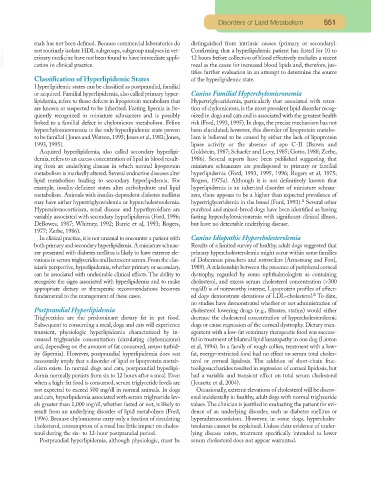Page 533 - Small Animal Clinical Nutrition 5th Edition
P. 533
Disorders of Lipid Metabolism 551
mals has not been defined. Because commercial laboratories do distinguished from intrinsic causes (primary or secondary).
VetBooks.ir not routinely isolate HDL subgroups, subgroup analyses in vet- Confirming that a hyperlipidemic patient has fasted for 10 to
12 hours before collection of blood effectively excludes a recent
erinary medicine have not been found to have immediate appli-
cation in clinical practice.
meal as the cause for increased blood lipids and, therefore, jus-
tifies further evaluation in an attempt to determine the source
Classification of Hyperlipidemic States of the hyperlipidemic state.
Hyperlipidemic states can be classified as postprandial, familial
or acquired. Familial hyperlipidemia, also called primary hyper- Canine Familial Hyperchylomicronemia
lipidemia, refers to those defects in lipoprotein metabolism that Hypertriglyceridemia, particularly that associated with reten-
are known or suspected to be inherited. Fasting lipemia is fre- tion of chylomicrons, is the most prevalent lipid disorder recog-
quently recognized in miniature schnauzers and is possibly nized in dogs and cats and is associated with the greatest health
linked to a familial defect in chylomicron metabolism. Feline risk (Ford, 1993, 1995). In dogs, the precise mechanism has not
hyperchylomicronemia is the only hyperlipidemic state proven been elucidated; however, this disorder of lipoprotein metabo-
to be familial (Jones and Watson, 1995; Jones et al, 1983; Jones, lism is believed to be caused by either the lack of lipoprotein
1993, 1995). lipase activity or the absence of apo C-II (Brown and
Acquired hyperlipidemia, also called secondary hyperlipi- Goldstein, 1987; Schaefer and Levy, 1985; Gotto, 1988; Zerbe,
demia, refers to an excess concentration of lipid in blood result- 1986). Several reports have been published suggesting that
ing from an underlying disease in which normal lipoprotein miniature schnauzers are predisposed to primary or familial
metabolism is markedly altered. Several endocrine diseases alter hyperlipidemia (Ford, 1993, 1995, 1996; Rogers et al, 1975;
lipid metabolism leading to secondary hyperlipidemia. For Rogers, 1975a). Although it is not definitively known that
example, insulin-deficient states alter carbohydrate and lipid hyperlipidemia is an inherited disorder of miniature schnau-
metabolism. Animals with insulin-dependent diabetes mellitus zers, there appears to be a higher than expected prevalence of
a
may have either hypertriglyceridemia or hypercholesterolemia. hypertriglyceridemia in the breed (Ford, 1993). Several other
Hyperadrenocorticism, renal disease and hypothyroidism are purebred and mixed-breed dogs have been identified as having
variably associated with secondary hyperlipidemia (Ford, 1996; fasting hyperchylomicronemia with significant clinical illness,
DeBowes, 1987; Whitney, 1992; Barrie et al, 1993; Rogers, but have no detectable underlying disease.
1977; Zerbe, 1986).
In clinical practice, it is not unusual to encounter a patient with Canine Idiopathic Hypercholesterolemia
both primary and secondary hyperlipidemia.A miniature schnau- Results of a limited survey of healthy, adult dogs suggested that
zer presented with diabetes mellitus is likely to have extreme ele- primary hypercholesterolemia might occur within some families
vations in serum triglycerides and lactescent serum.From the clin- of Doberman pinschers and rottweilers (Armstrong and Ford,
ician’s perspective, hyperlipidemia, whether primary or secondary, 1989).A relationship between the presence of peripheral corneal
can be associated with undesirable clinical effects. The ability to dystrophy, regarded by some ophthalmologists as containing
recognize the signs associated with hyperlipidemia and to make cholesterol, and excess serum cholesterol concentration (>300
appropriate dietary or therapeutic recommendations becomes mg/dl) is of noteworthy interest. Lipoprotein profiles of affect-
a
fundamental to the management of these cases. ed dogs demonstrate elevations of LDL-cholesterol. To date,
no studies have demonstrated whether or not administration of
Postprandial Hyperlipidemia cholesterol lowering drugs (e.g., fibrates, statins) would either
Triglycerides are the predominant dietary fat in pet food. decrease the cholesterol concentration of hypercholesterolemic
Subsequent to consuming a meal, dogs and cats will experience dogs or cause regression of the corneal dystrophy. Dietary man-
transient, physiologic hyperlipidemia characterized by in- agement with a low-fat veterinary therapeutic food was success-
creased triglyceride concentration (circulating chylomicrons) ful in treatment of bilateral lipid keratopathy in one dog (Linton
and, depending on the amount of fat consumed, serum turbid- et al, 1994). In a family of rough collies, treatment with a low-
ity (lipemia). However, postprandial hyperlipidemia does not fat, energy-restricted food had no effect on serum total choles-
necessarily imply that a disorder of lipid or lipoprotein metab- terol or corneal lipidosis. The addition of short-chain fruc-
olism exists. In normal dogs and cats, postprandial hyperlipi- tooligosaccharides resulted in regression of corneal lipidosis, but
demia normally persists from six to 12 hours after a meal. Even had a variable and transient effect on total serum cholesterol
when a high-fat food is consumed, serum triglyceride levels are (Jeusette et al, 2004).
not expected to exceed 500 mg/dl in normal animals. In dogs Occasionally, extreme elevations of cholesterol will be discov-
and cats, hyperlipidemia associated with serum triglyceride lev- ered incidentally in healthy, adult dogs with normal triglyceride
els greater than 1,000 mg/dl, whether fasted or not, is likely to values.The clinician is justified in evaluating the patient for evi-
result from an underlying disorder of lipid metabolism (Ford, dence of an underlying disorder, such as diabetes mellitus or
1996). Because chylomicrons carry only a fraction of circulating hyperadrenocorticism. However, in some dogs, hypercholes-
cholesterol, consumption of a meal has little impact on choles- terolemia cannot be explained. Unless clear evidence of under-
terol during the six- to 12-hour postprandial period. lying disease exists, treatment specifically intended to lower
Postprandial hyperlipidemia, although physiologic, must be serum cholesterol does not appear warranted.

